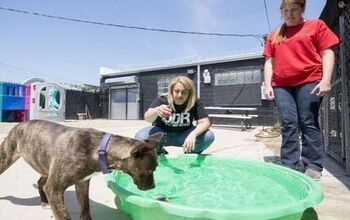What Is A No-Kill Shelter?

Did you know that there are different kinds of shelters to help animals in need? Let’s go over what a no-kill shelter is and how it differs from other animal shelters.
For many years, animal shelters typically had policies which regulated how long an animal could stay in the shelter without being adopted. If the animal reached that point, it would be euthanized to make room for another more adoptable pet. About two decades ago, a shelter in San Francisco started what is known as the “no-kill” movement which put an end to this type of policy to guarantee a home for every adoptable pet.
United States Shelter Statistics
There are an estimated 14,000 shelters and rescue groups throughout the United States which take in a combined total of nearly 8 million pets each and every year. Many of these rescue groups are small, run out of people’s homes, and they have a limited capacity. Shelters often rely on volunteers to run the shelter and to provide foster homes for adoptable pets when the shelter has reached capacity. Since the beginning of the no-kill movement, the number of pets euthanized in shelters each year dropped from around 20 million to just 3 million.
Related: New Study To Examine Why Owners Surrender Dogs To Shelters
What is a No-Kill Shelter?
A no-kill shelter is an animal shelter that has a policy against euthanizing healthy or treatable pets, even if the shelter is full. This does not necessarily mean that the shelter doesn’t euthanize any animals – it simply means that euthanasia is reserved for animals that are terminally ill and those that may be considered dangerous. Even shelters with no-kill policies still euthanize an average of 10 percent of the animals that walk through their doors but they make every effort to treat or socialize the animal before considering euthanasia as an option.
Are There Problems With No-Kill Shelters?
Using the "No-Kill" Label for Marketing
Some organizations have adopted the “no-kill shelter” as a marketing term, as some people do not understand what it really means. This isn’t a term that is regulated. Unless someone sets out to dig into a shelter’s records, they may be able to operate under the guise of “No-Kill” to receive more support for the community without following through on this promise. This isn’t to say that there aren’t great examples of organizations operating in this way. But there are also shelters and rescue organizations that have been found dumping their animals in the nearest kill shelter if they have been with them for too long.
Strain on Resources
Unfortunately, the number of animals available for adoption still greatly exceeds the number of available homes. As a result, many pets spend months (some even spend years) in the shelter system before they are adopted. Many no-kill shelters operate at capacity on a regular basis and, if the shelter is full, they may turn away animals that are in need such as those in abusive situations.
This strain on resources doesn’t stop with just the lack of space for animals in need. In addition to a shortage of kennels and foster homes, shelters operating under the “No-Kill” model are often faced with financial challenges. The animals in their care need to be fed and provided with veterinary care (including basic preventative care) while they are with them. This adds up, and fast! When finances are tight, they may be forced to make difficult decisions like euthanizing a pet for medical reasons that could have otherwise been saved if the funds were available.
Behavioral Issues
Some of these adopted pets are returned to the shelter (not necessarily a no-kill shelter) after adoption for behavior problems or other issues. This could be the result of a lack of funding to properly address behavioral concerns.
While it is controversial, there are also some that question whether every dog that is saved and adopted out should be adopted by the general public. Some “No-Kill” shelters have been accused of overlooking behavioral issues to increase the adoption rate and acquire more funding for their operations. While the additional adopting fees are helpful, the failure to address behavioral problems not only puts the dog at risk but also the adopting family.
Some dogs will withdraw over time, hurting their chances of being adopted. Others will withdraw to the point of showing fear aggression or reactivity. This can open the door for issues moving forward with the dog being seen as a bite risk. Finally, some dogs will respond to the stressful setting in the opposite way, by becoming openly reactive and lashing out at people and other dogs around them. While most of these behaviors can be prevented completely or in part with the use of foster placement, the demand for available foster homes can make it difficult to put dogs into the right environment for their needs.
Clearly, there are issues with any kind of shelter situation, and no-kill shelters are not immune to the problems that can plague any rescue organization.
Related: How To Help Dog Shelters When You Can’t Adopt
Why a Focus on Low Euthanasia Rates Can Be a Problem
As animal lovers and supporters of the rescue movement, we are often faced with deciding where to donate our hard-earned dollars. Especially with so many great shelters and rescue organizations operating around us. This leads us to look at a rescue’s efforts with a watchful eye, assessing statistics and weighing in on our opinions.
This level of accountability is important and necessary to keep organizations on track as they grow and evolve. But the problem arises with what data we are using to make this assessment.
For many organizations, the target goal is for 90% or more of the animals that come into their shelter to leave alive. Over time, however, this focus on stats and numbers can take away from the truth about the animals being adopted out. To keep their numbers up and acquire funding, rescues may prolong the lives of animals that would have been better served with humane euthanasia. There are times when it is the most compassionate choice!
What Can You Do To Help?
The reality of the matter is that there are just too many homeless pets out there for all of them to find a healthy, happy home. Shelters adopt a number of policies to help reduce this problem by spaying/neutering all of their pets and by requiring adopters to fill out applications to help prevent the animals from going to a home where they may be abused or neglected. Many shelters struggle to stay afloat against the rising tide of animal homelessness and they often rely on volunteers and donations because funding simply isn’t available. If you want to help reduce the homeless pet population, do your part by having your own pets spayed/neutered and consider volunteering at or donating to your local shelter.

Kate Barrington is the loving owner of two cats (Bagel and Munchkin) and a noisy herd of guinea pigs. Having grown up with golden retrievers, Kate has a great deal of experience with dogs but labels herself a lover of all pets. Having received a Bachelor's degree in English, Kate has combined her love for pets and her passion for writing to create her own freelance writing business, specializing in the pet niche.
More by Kate Barrington























